This year, we celebrated President’s Day with a return visit to Mount Vernon and by whipping up a batch of George Washington’s favorite hoecakes.
After reading Dining with the Washingtons: Historic Recipes, Entertaining, and Hospitality from Mount Vernon (Mount Vernon Ladies’ Association, 2011), I was especially anxious to check out “Hoecakes and Hospitality: Cooking with Martha Washington,” a special exhibition at the new Donald W. Reynolds Museum and Education Center, a truly fabulous place with its many galleries and theatres, interactive displays, fascinating exhibits and 700+ objects illuminating the style, taste, and personalities of the Washingtons, their life at the Estate, the presidency and the Revolutionary War.
* * *
THE EXHIBIT
The “Hoecakes and Hospitality” exhibit featured a behind-the-scenes look at how food was prepared and presented at Mount Vernon. Martha was in charge of overseeing all activities involved in food preparation and service (kitchen, kitchen garden, dairy, smokehouse, larder, dining room), supervising a staff of enslaved cooks, housekeepers, butlers and waiters, and of course coordinating menu selection.
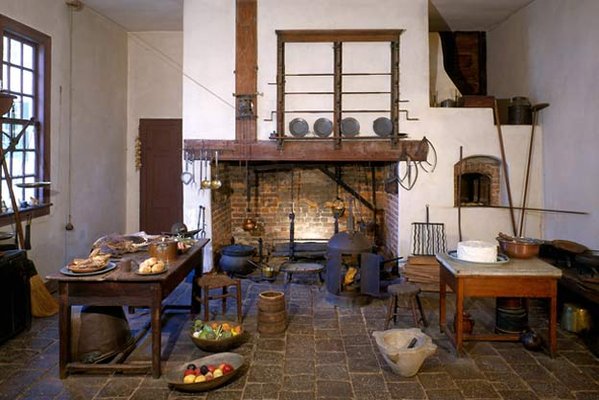
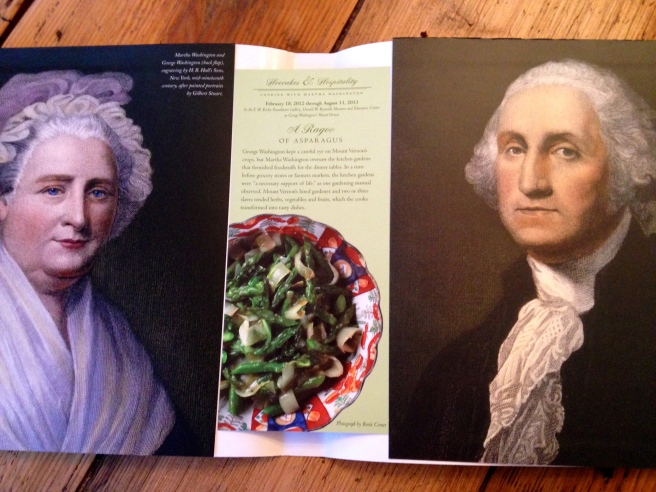
Mount Vernon was basically self-sufficient when it came to food (five farms, smokehouse, distillery, gristmill, orchards, gardens, fishery), and the Washingtons entertained hundreds of national and international guests each year, many of them uninvited. Martha was always the gracious hostess, her warm and friendly personality nicely balancing out her husband’s more reserved nature.
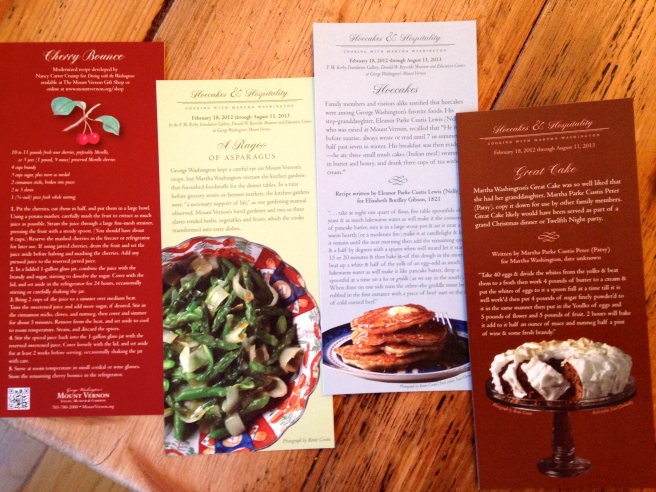
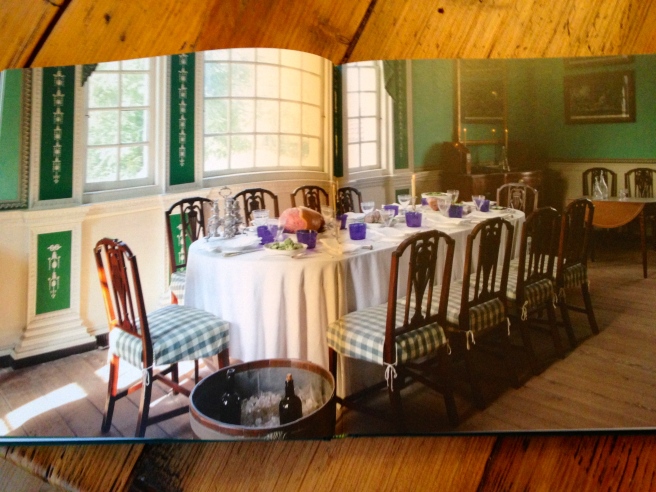
It was great fun seeing Martha’s cookbooks and handwritten recipes and dinner invitations, kitchen bells, and various 18th century cooking utensils and tableware, which renewed my appreciation for their laborious, entirely “from-scratch” method of food production that’s so different from the way we do things now with our sophisticated kitchen equipment and convenience foods. While today there is a “movement” for organic, locally sourced foods in season, back then our forefathers really had no choice but to cultivate their own crops and avail themselves of the bounty found in woods, field, and stream.
Hams cured in the Estate smokehouse held special prominence on the Washington family tables; Martha took great pride in overseeing each stage of the curing process and hams were often shipped as gifts domestically and abroad. In addition to fresh seasonal vegetables (beans, lettuces, peas, cabbages, parsnips, potatoes, cauliflower), a typical dinner included a variety of meats. A few guests recorded their memorable meals in detail, like this account by Joshua Brookes (1799):
The table was arranged with a leg of boiled pork at the head, a goose at the foot, and the following dishes arranged around the table: roast beef, round cold boiled beef, mutton chops, hominy, cabbage, potatoes, pickles, fried tripe, and onions. Beverages offered during dinner included wine, porter, and beer. The tablecloth was wiped off before the second course, which included mince pies, tarts, and cheese. The cloth was then removed altogether and port and madeira, as well as two kinds of nuts, apples, and raisins were set out.
Through reading Dining with the Washingtons, I learned that Madeira wine was a particular favorite of the President; it was imported along with teas, spices, some beers, coffee, chocolate, olives, and exotic fruits like pineapple, coconut, and mango. He was very fond of fish and nuts; the Washingtons enjoyed a lot of oysters, lobsters, shad and cod. But for all the bounteous feasts lavished upon his guests, Washington himself had simple tastes and was basically a modest person not particularly fond of small talk or big parties. In a letter to his friend George Fairfax, he said:
My manner of living is plain . . . A glass of wine and a bit of mutton is always ready — such as will be content to partake of it are welcome — those who look for more will be disappointed.
* * *
THE HOECAKES
Perhaps what best represents the essence of Washington’s plain tastes is his favorite breakfast, hoecakes. He woke up each morning at dawn, spent several hours reading and tending to correspondence, and inspected his stables and kennels before sitting down to breakfast promptly at 7 a.m.
He liked three hoecakes “swimming in butter and honey,” which he washed down with three cups of tea (Hyson being a particular favorite) without cream. You probably know that hoecakes were ubiquitous during Colonial times and is distinctly American, having originated with the Native Americans and eaten by African slaves as well as European settlers.
It’s basically a cornmeal mush flatbread cooked on a griddle, sometimes baked. Hoecakes, as they are known in the South, were also called johnnycakes (New England), journey cakes, ash cakes, shawnee cake, mush cakes and jonnybread. Field hands used to cook theirs on the blade of a hoe held over an open flame. Hoes designed for cotton fields were large and flat (I saw one in the exhibit). 🙂
* * *
THE RECIPES
Years after he died, Washington’s step-granddaughter Nelly Custis Lewis confirmed his love for hoecakes and described how she made them:
. . . take at night one quart of flour, five table spoonfuls of yeast & as much lukewarm water as will make it the consistency of pancake batter, mix it in a large stone pot & set it near a warm hearth (or a moderate fire) make it at candlelight & let it remain until the next morning then add the remaining quart & a half by degrees with a spoon when well mixed let it stand 15 or 20 minutes & then bake it — of this dough in the morning, beat up a white & half of the yolk of an egg — add as much lukewarm water as will make it like pancake batter, drop a spoonful at a time on a hoe or griddle (as we say in the south). When done on one side turn the other — the griddle must be rubbed in the first instance with a piece of beef suet or the fat of cold corned beef.
I made the recipe found in Dining with the Washingtons, adapted for the modern cook by culinary historian Nancy Carter Crump.
It’s simple to make, but takes a little advance planning, as does any recipe calling for yeast. Although it looks like a pancake, it’s not light and fluffy like your favorite buttermilk pancakes. These are rather dense and take longer to cook (5 minutes each side) and are tastier with lots of butter and honey (or maple syrup). Just two of these sated my hunger for a few hours — I can now see how George’s three hoecakes tided him over for the next 8 hours until dinner at 3 p.m., their main meal of the day.
Eating hoecakes is a lovely way to connect with the past and channel the Father of Our Country. 🙂
GEORGE WASHINGTON’S FAVORITE HOECAKES
modernized recipe developed by Nancy Carter Crump
1/2 teaspoon active dry yeast
2-1/2 cups white cornmeal, divided
3 to 4 cups lukewarm water
1/2 teaspoon salt
1 large egg, lightly beaten
melted butter and honey or maple syrup for serving
1. Mix the yeast and 1-1/4 cups of the cornmeal in a large bowl. Add 1 cup of the lukewarm water, stirring to combine thoroughly. Mix in 1/2 cup more of the water, if needed, to give the mixture the consistency of pancake batter. Cover with plastic wrap, and refrigerate for at least 8 hours or overnight.
2. Preheat oven to 200 degrees F.
3. When ready to finish the hoecakes, begin by adding 1/2 to 1 cup of the remaining water to the batter. Stir in the salt and the egg, blending thoroughly.
4. Gradually add the remaining 1-1/4 cups of cornmeal, alternating with enough additional lukewarm water to make a mixture that is the consistency of waffle batter. Cover with a towel, and set aside at room temperature for 15 to 20 minutes.
5. Heat a griddle on medium-high heat, and lightly grease it with lard or vegetable shortening. Preparing one hoecake at a time, drop a scant 1/4 cup of the batter onto the griddle and cook on one side for about 5 minutes, or until lightly browned. With a spatula, turn the hoecake over and continue cooking another 4 to 5 minutes, until browned.
6. Place the hoecake on a platter, and set it in the oven to keep warm while making the rest of the cakes. Drizzle each one with melted butter.
7. Serve the hoecakes warm, drizzled with melted butter and honey or maple syrup.
~ from Dining with the Washingtons, edited by Stephen A. McLeod (Mount Vernon Ladies’ Association, 2011).
* * *

Dining with the Washingtons is a well-researched, lushly illustrated, beautifully designed coffee table book containing highly readable and engaging historical essays, gorgeous color photographs, artwork, and more than 90 delectable 18th century recipes.
I especially like seeing the china, porcelain, flatware, and silver used at Mount Vernon, because it reflects the Washingtons’ refined tastes, personality and family history. If I were to visit, I might have tea with George and Martha on the portico, sip Hyson or Bohea from an export China cup graced with delicate polychrome scenes, or slurp (politely, of course) garden pea soup from a Staffordshire creamware soup plate in the small dining room. I would hold fast to the ham, lest the hound Vulcan make off with it in a mad dash, and refrain from trying my hosts with too much chitchat.
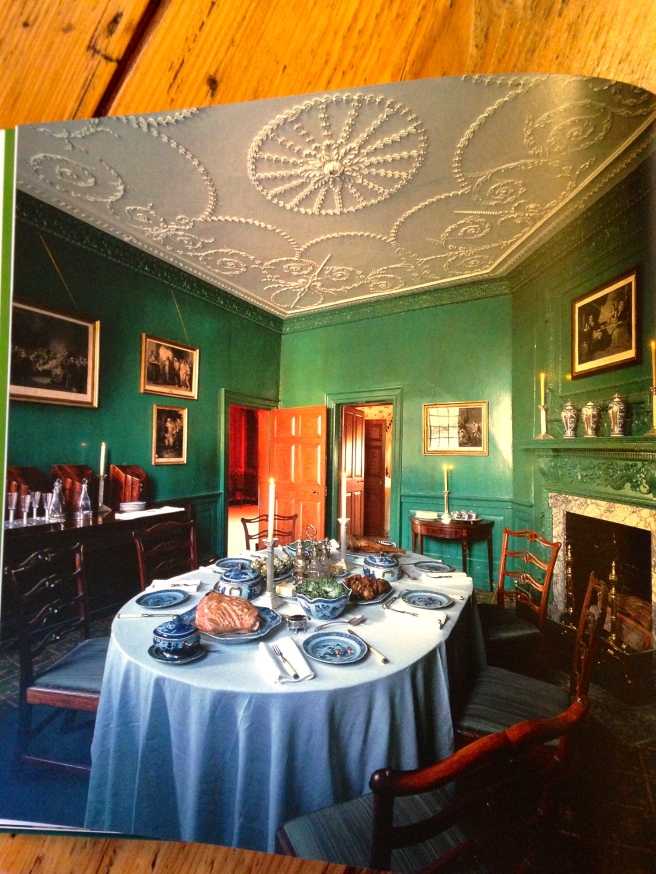
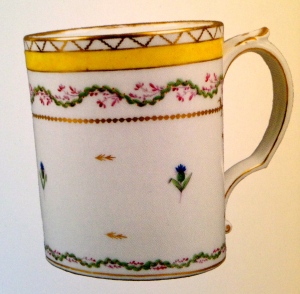
We topped off our visit with lunch at the Mount Vernon Inn (Len had an Old Virginia Ham Sandwich and I had the Colonial Turkey Pye) and a quick browse through the gift shops, where George himself convinced me to purchase a doll’s tea set for Cornelius. The pattern, Ribbons and Cornflower, was modeled after a large French porcelain mug used by George during his Presidency, manufactured by Christopher Potter (Paris, 1790-95). Apparently he drank neither coffee nor tea from it, more likely beer or ale.
Friday is George Washington’s actual birthday. Somewhere he’s having salt cod with egg sauce, a piece of Martha’s Great Cake, and a big bowl of ice cream. Cornelius drinks neither beer nor ale, but is happy to toast George with fresh apple cider in his new cup and saucer. Since the General loves nuts, Cornelius has also volunteered to polish off a piece of pecan pie. 🙂
Happy 281st Birthday, George!
* * *
♥ Enjoy this short video about the “Hoecakes and Hospitality” Exhibit to see some of the objects on display.
* * *
” Be courteous to all, but intimate with few, and let those few be well tried before you give them your confidence.” ~ George Washington
* * *
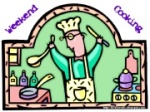 This post is being linked to Beth Fish Read’s Weekend Cooking, where all are invited to put on their best bibs and aprons, and share their food-related posts (reviews, recipes, photos, musings, etc.).
This post is being linked to Beth Fish Read’s Weekend Cooking, where all are invited to put on their best bibs and aprons, and share their food-related posts (reviews, recipes, photos, musings, etc.).
———————————————————
Copyright © 2013 Jama Rattigan of Jama’s Alphabet Soup. All rights reserved.

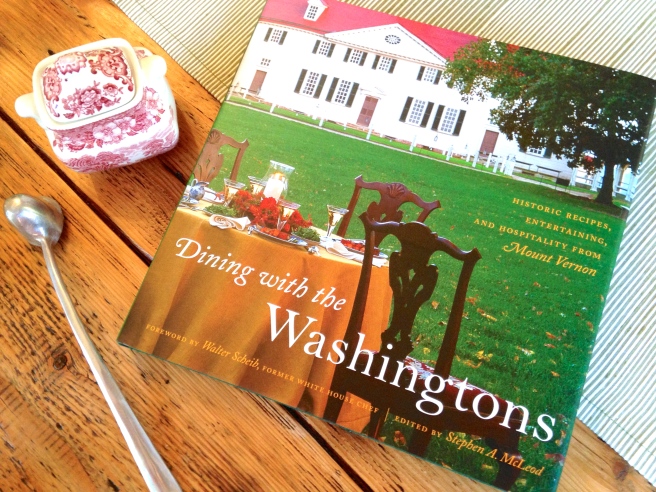


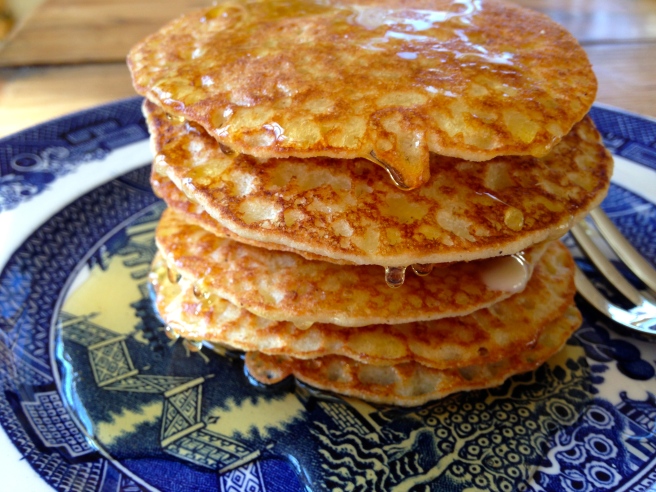
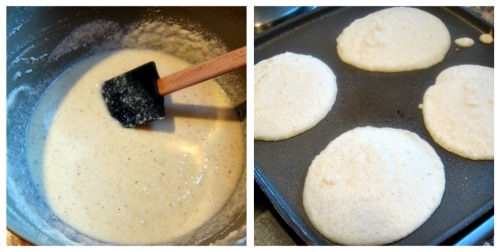
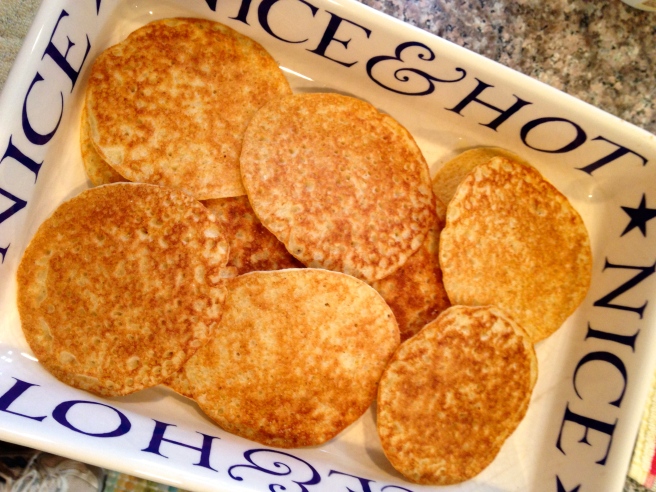
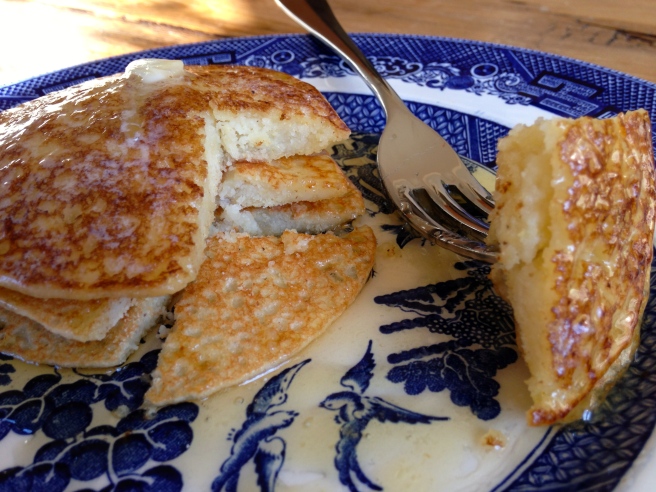
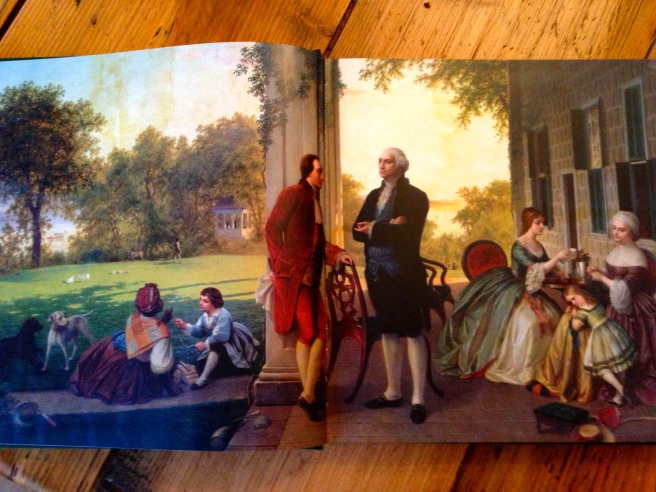
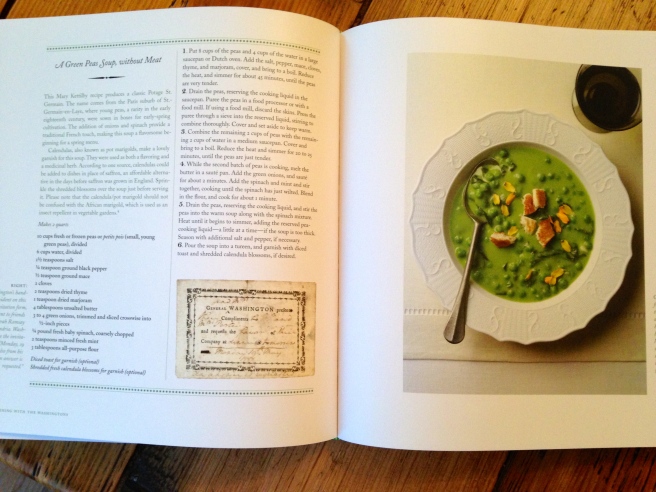
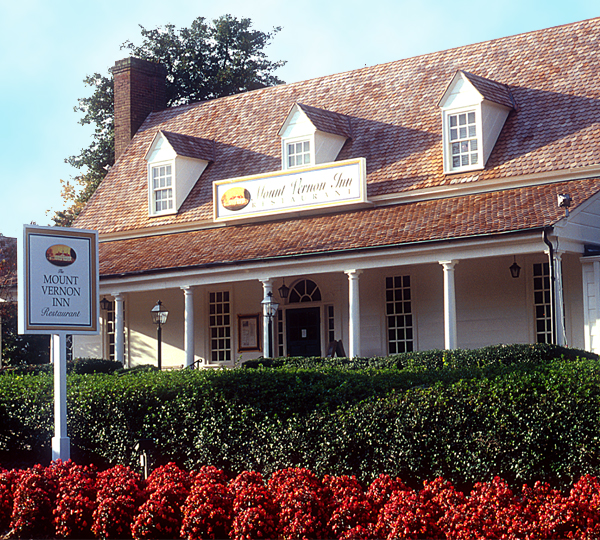
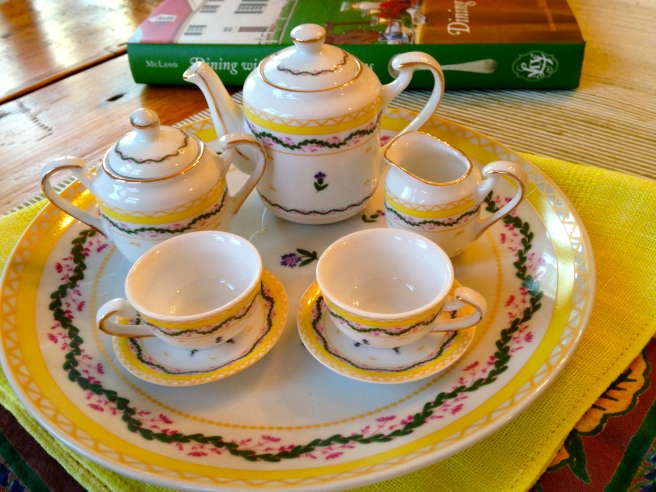
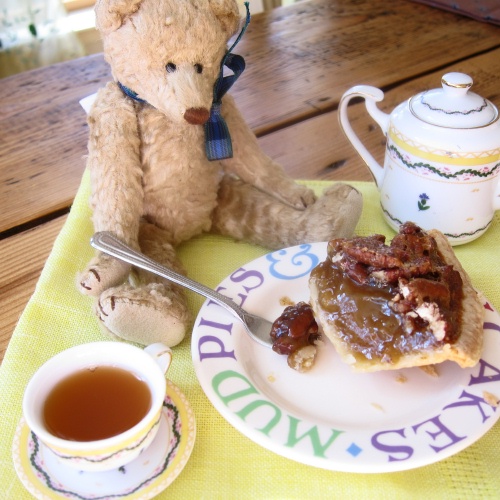
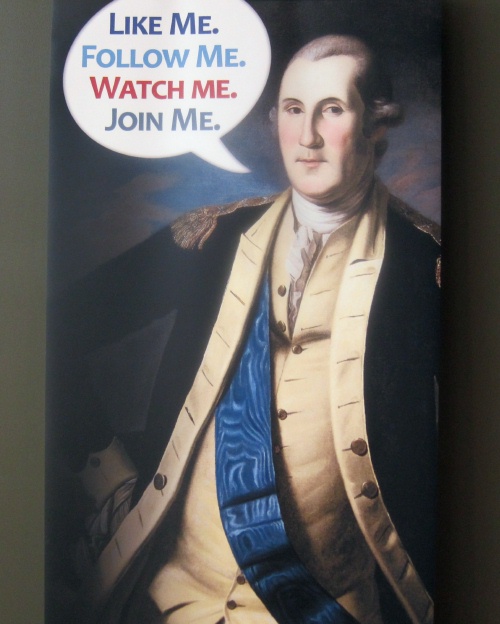
Excellent post. I love when food and history meet. Kudos.
LikeLike
Thanks for reading and commenting!!
LikeLike
Ha ha! I have a similar post coming up in two days INCLUDING the very same recipe for hoe cakes! But alas, none of my posts could ever be as beautiful as yours! But back to hoe cakes – they sound really good don’t they? I loved the part “swimming in butter and honey” and also focus on that! LOL Great minds (and great foodophiles!) think alike! (but I keep wondering, will my statin meds be able to cope? ha ha)
LikeLike
Great minds do indeed think alike!
Have you made them yet? I’m not sure my yeast rose enough. Refrigerating the batter after adding the lukewarm water the first time didn’t make that much sense to me — nor did adding lukewarm water to a cold, just-from-the-fridge batter the next day. Nelly left the whole thing out at room temp. I’ve seen other hoecake recipes calling for self-rising flour — a combo of wheat flour with cornmeal — a good idea for those wanting a less dense/heavy hoecake.
Anyway, can’t wait to see your post!
LikeLike
Thank you for another delightful (and delicious) food adventure. I will be trying the recipe.
LikeLike
Anxious to hear how it turns out :)!
LikeLike
Jama, you have the liveliest and most intriguing blog around! I so enjoy the way you connect food, books (especially children’s books), holidays and event current events. And you never run out of interesting ideas!
LikeLike
Aw thanks, Mary. I run out of ideas all the time . . . and then someone or something inspires me. 🙂
LikeLike
I enjoy reading your posts in the morning hours or at night–times of relaxation to fully savor these quiet moments steeped in food and revelation. Thanks again.
LikeLike
I appreciate your taking the time to read, Tam. Happy you’re finding things to nourish your mind and heart here. 🙂
LikeLike
What a great idea! I have been wanting to go to Mount Vernon, too. I hope we make it there in the spring. We’re going to the White House for a tour on Friday — seems like a nice time to be there 🙂
LikeLike
Have you been to MV before? Lots to see and lots of walking. We take it in small doses. The Museum was new to us so we checked it out (had already toured the Mansion a couple of times in the past).
Enjoy your White House tour. Is it the regular public tour? I remember it being pretty short and they didn’t let us see the kitchen or dining rooms — for me, the most important parts of any house 🙂 . . .
LikeLike
It was the regular tour, but we were lucky that they did it slowly because of a slow group in front of us. And at the end, a gospel choir sang! I almost burst into tears, they were so grand.
LikeLike
Jama, I so enjoyed everything about this post–photos, video, recipes, etc. It’s only a short distance from my son’s home, so perhaps he’ll take me for a tour on my next visit.
LikeLike
You’ll enjoy it, Kathleen. Besides the Mansion itself, there are about a dozen outbuildings to see, in addition to the new Museum/Education Center complex.
LikeLike
I really enjoyed reading about this post my friendd thank you 😀
It would be such a fun tour!
Cheers
CCU
LikeLike
If you ever visit Virginia, put Mount Vernon on your list! Thanks for reading, Uru :).
LikeLike
Sorry I missed this yesterday Jama. Your tour sounds delightful & those pictures of the hoecakes look divine. I’m not so sure I’ll ever make them, but perhaps I’ll try. We love original waffle recipes & mostly stick to them when we cook these kinds of treats. Amazing hearing about this fast farm of the Washington’s though. I think I saw it long ago on my first trip to D.C., but don’t remember any of it. It must have been an amazing time, if one was wealthy. Hard work for all the rest of the people.
LikeLike
What’s good about this book is that it also discusses the crucial role of slaves and hired servants in keeping Mount Vernon up and running. They definitely worked very hard behind the scenes. Washington’s will stipulated that upon his death, all his slaves would be granted their freedom.
Washington expanded the Mount Vernon Estate to include five working farms (each with its own overseer) to maintain self-sufficiency, but they were wealthy enough to import some goods (most of their beverages, for example) from different parts of the world.
LikeLike
Hi, Jama! I chaperoned a field trip to Mount Washington when my son was in fifth grade. What a memorable trip, but I don’t remember any of that pecan pie. Yum. George and I share a birthday. I will think of his mechanical dentures when I’m enjoying my cake tomorrow.
LikeLike
Happy Birthday, Laura! Do eat some cake for me — Cornelius is only too happy to eat another pie or two in your honor :).
LikeLike
Given how popular the oatmeal pancakes still are at our house (MiniPlu asks for them for her birthday – they’re THAT beloved), I’m definitely going to have to give these hoecakes a try as well! *prints recipe*
LikeLike
I recommend NOT refrigerating the batter, just leaving it out at room temp for 8 hours (or overnight). I think mine could have risen more. 🙂
LikeLike
I left the batter out overnight as you suggested; don’t know how the fluffiness compared to yours. They’re still pretty sturdy, but they didn’t seem like bricks. I do wish there’d been some sugar in the recipe – I think that would have helped a lot. So – not a huge winner with this recipe, but I’ll still eat the remaining hoecakes for upcoming breakfasts – just with quite a bit of jam.
LikeLike
The recipe was adapted to be as authentic as possible to the original 18th century one, and as I pointed out, it’s not meant to be like our modern day light and fluffy pancakes. Lots of honey (or jam) and butter are key to enjoying them, as GW himself knew :).
LikeLike
Another awesome post. I love these types of cookbooks and reading about the everyday meals and parties from days gone by — whether served by presidents and kings or by regular old commoners. Hoecakes indeed are very American — as is anything corn. I also adore the tea set!
LikeLike
I like George’s taste in china patterns; they have an understated elegance. The dolls teaset is fun to own — of course I’m thinking it would be nice to get some full size pieces to match.
I also enjoy historic recipes and learning about how our ancestors managed without all our modern conveniences.
LikeLike
Great pictures and information again. Love the hoecake recipe. The books sounds very interesting, it is great to learn more about the everyday life of the famous in the past.
LikeLike
It’s a lovely book — the photographs are gorgeous and I think the photographer(s) should have been given more prominent billing. Rénee Comet did the food photography but I’m not sure who did the objects and artifacts.
LikeLike
This looks like a really interesting book; I adore this kind of cookbooks. Thanks for sharing the hoecakes recipe, I don’t think I’ve ever had them. I love the picture of Cornelius!
LikeLike
Cornelius thanks you for noticing him. He likes the attention :).
This was the second hoecake recipe I’ve tried, the first using yeast. Not entirely sure mine turned out right.
LikeLike
Great pics. The Great Cake, with 40 eggs, seems rather daunting.
LikeLike
Just cracking 40 eggs would tire me out! LOL
LikeLike
What a lovely post. I would so like to go to Mount Vernon. Have a great week.
LikeLike
Hope you get to visit MV someday, Carole.
LikeLike
Wonderful post! We love Mt. Vernon and have visited a couple of times (the Mount Vernon Inn, too). The new education center is amazing.
LikeLike
It’s definitely an interesting place to visit — glad I finally saw the new museum and education center. 🙂
LikeLike
What a wonderful recipe – I love when history meets cooking, it gives one a real sense of the past. Thank you for posting!
LikeLike
Thanks so much for reading! Glad you enjoyed the post :).
LikeLike
I love historical cookbooks and had not heard about this one. Thanks for the heads up.
LikeLike
I found this book very “readable” for a coffee table type book. The recipes make it a practical resource as well :).
LikeLike
I would love that beautiful work space in the Mount Vernon kitchen! All that table space-lovely. What a great post Jama.
LikeLike
And nary a KitchenAid in sight :). Glad you liked the post, Michelle!
LikeLike
This sounds like a fascinating book! Thank you so much for sharing 🙂
LikeLike